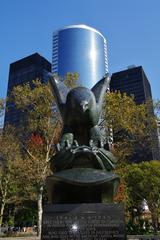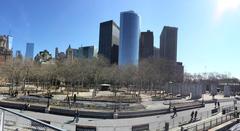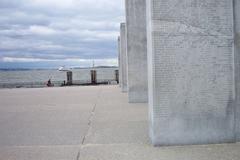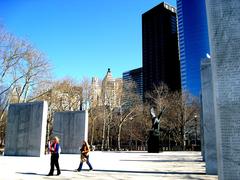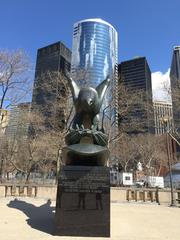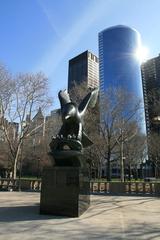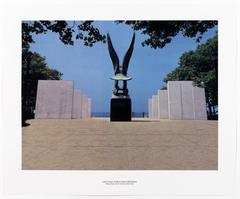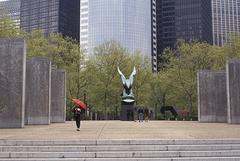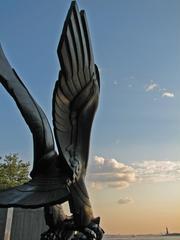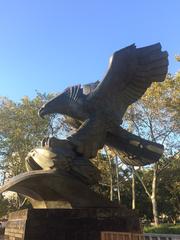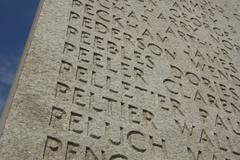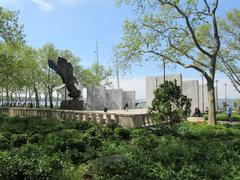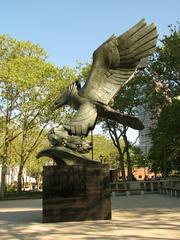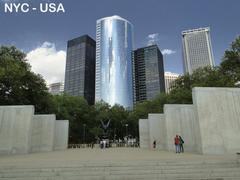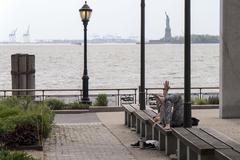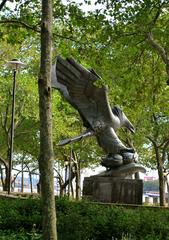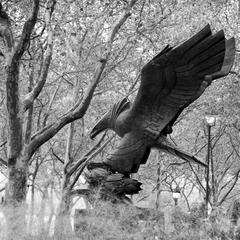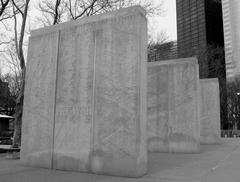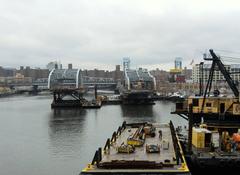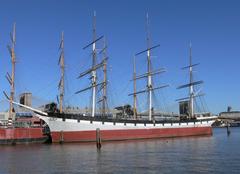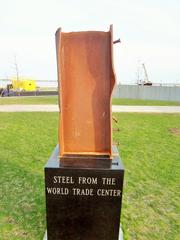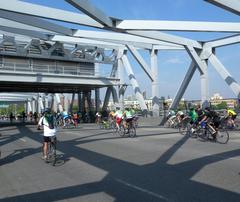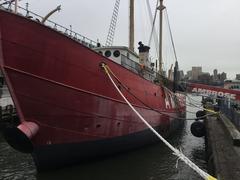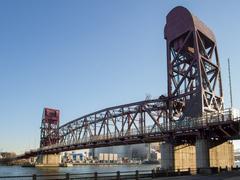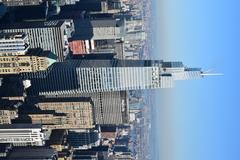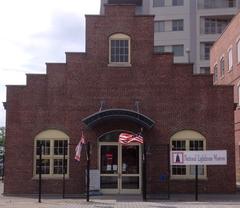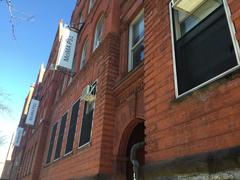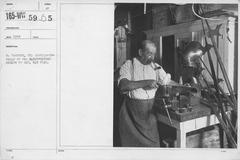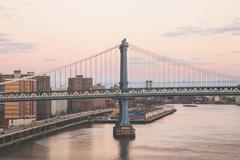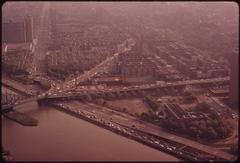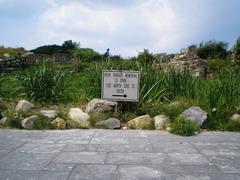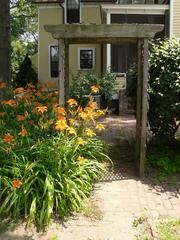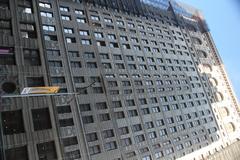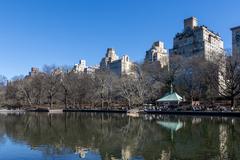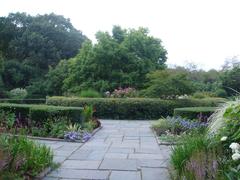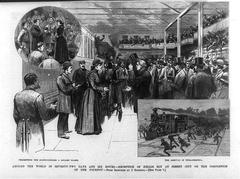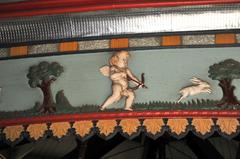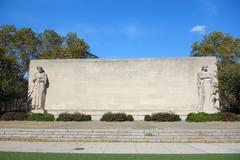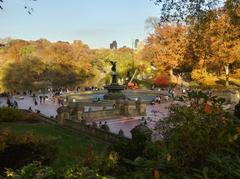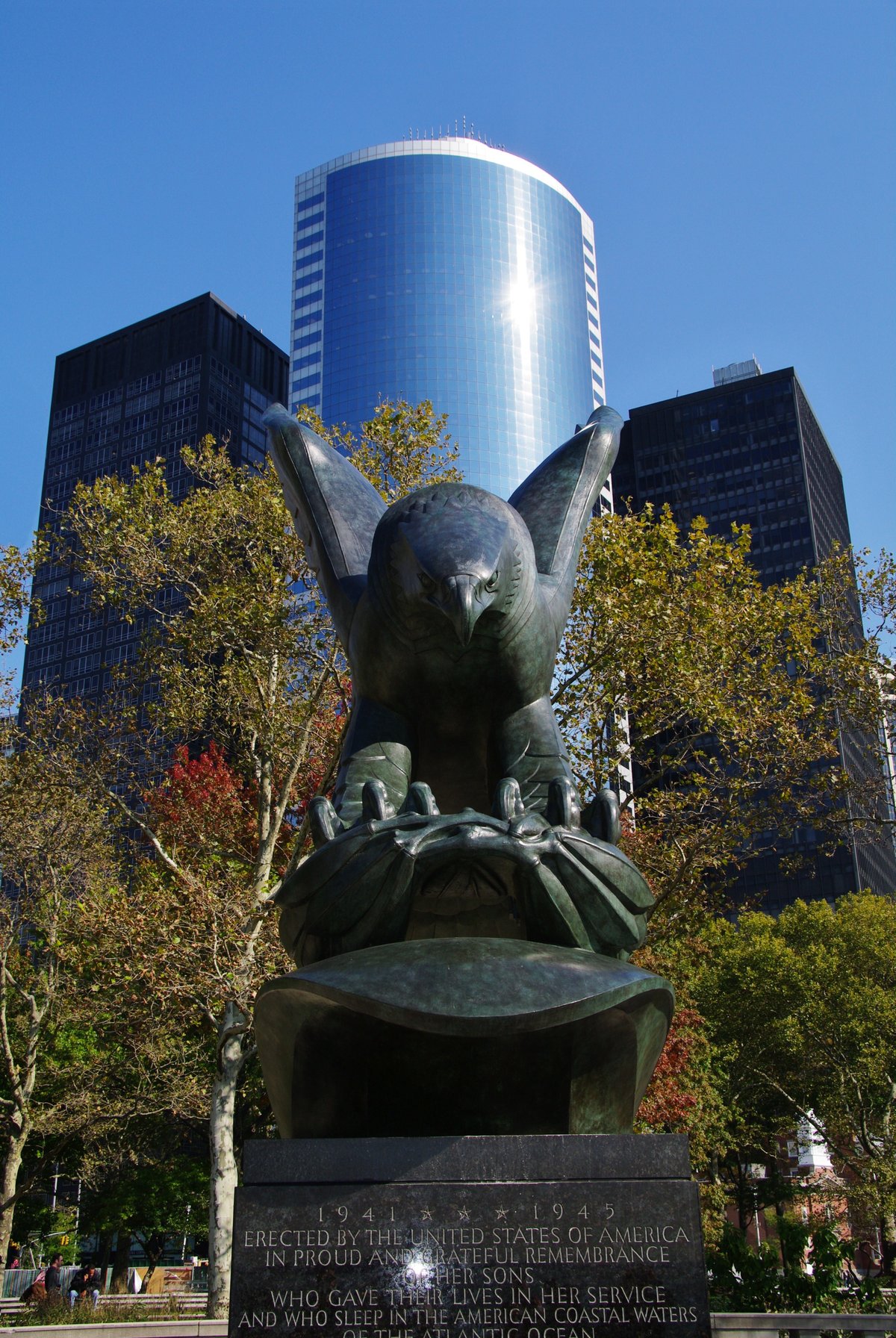
Guide to Visiting East Coast Memorial, New York City
Date: 31/07/2024
Introduction
The East Coast Memorial, nestled in the heart of Battery Park at the southern tip of Manhattan, New York City, stands as a solemn testament to the 4,611 American servicemen who lost their lives in the Atlantic Ocean during World War II. This memorial, commissioned by the American Battle Monuments Commission (ABMC) and designed by the architectural firm Gehron & Seltzer, was constructed between 1959 and 1963, with its dedication led by President John F. Kennedy on May 23, 1963 (ABMC). It features eight towering granite pylons inscribed with the names of the fallen, arranged in a semicircle around a majestic bronze eagle sculpture by Albino Manca, symbolizing the honor and victory of these brave individuals (NYC Parks) (Walkabout NY).
The memorial not only serves as a place of remembrance but also offers a profound historical context, highlighting the significant role of American forces in the Atlantic theater during World War II. The Atlantic Ocean was a critical battleground where the U.S. Navy, Marine Corps, Coast Guard, Army Air Forces, and Merchant Marine faced perilous conditions, including enemy attacks and treacherous weather, to support Allied efforts in Europe (Downtown NY). The East Coast Memorial thus holds immense cultural and educational value, frequently included in history tours and educational programs, and serving as the site for various commemorative events such as Memorial Day and Veterans Day ceremonies (A View on Cities).
This guide aims to provide a comprehensive overview of visiting the East Coast Memorial, covering its historical significance, architectural design, visitor information, and nearby attractions. Whether you are a history enthusiast, a student, or a tourist, this guide will help you make the most of your visit to this poignant and historically rich site.
Table of Contents
- [Origins and Construction](#origins-and-constructionorigins-and-construction)
- [Architectural Design](#architectural-designarchitectural-design)
- [Historical Context](#historical-contexthistorical-context)
- [Dedication and Public Reception](#dedication-and-public-receptiondedication-and-public-reception)
- [Cultural and Educational Impact](#cultural-and-educational-impactcultural-and-educational-impact)
- [Preservation and Maintenance](#preservation-and-maintenancepreservation-and-maintenance)
- [Visitor Experience](#visitor-experiencevisitor-experience)
- [Accessibility and Amenities](#accessibility-and-amenitiesaccessibility-and-amenities)
- [Visiting Hours and Tickets](#visiting-hours-and-ticketsvisiting-hours-and-tickets)
- [Commemorative Events](#commemorative-eventscommemorative-events)
- [Nearby Attractions](#nearby-attractionsnearby-attractions)
- [Future Developments](#future-developmentsfuture-developments)
- [Frequently Asked Questions (FAQ)](#frequently-asked-questions-faqfrequently-asked-questions-faq)
- [Call to Action](#call-to-actioncall-to-action)
- [Visuals and Media](#visuals-and-mediavisuals-and-media)
Origins and Construction
The East Coast Memorial, located in Battery Park, Manhattan, is a poignant tribute to the American servicemen who lost their lives in the Atlantic Ocean during World War II. The memorial was commissioned by the American Battle Monuments Commission (ABMC) and was designed by the renowned architect, Gehron & Seltzer. The construction of the memorial began in 1959 and was completed in 1963. The memorial was officially dedicated on May 23, 1963, by President John F. Kennedy.
Architectural Design
The East Coast Memorial is an impressive architectural feat, featuring eight massive granite pylons arranged in a semicircle. Each pylon stands 19 feet tall and is inscribed with the names of 4,611 American servicemen who perished in the Atlantic Ocean during World War II. The names are listed alphabetically, providing a solemn and orderly tribute to those who gave their lives. At the center of the semicircle stands a bronze statue of an eagle, designed by the sculptor Albino Manca. The eagle holds a laurel wreath in its talons, symbolizing victory and honor.
Historical Context
The East Coast Memorial serves as a reminder of the significant role the United States played in the Atlantic theater during World War II. The Atlantic Ocean was a critical battleground, with American forces engaged in numerous naval battles and convoy missions to support Allied efforts in Europe. The memorial honors those who served in the U.S. Navy, Marine Corps, Coast Guard, Army Air Forces, and the Merchant Marine. These servicemen faced perilous conditions, including enemy attacks, treacherous weather, and the constant threat of submarine warfare.
Dedication and Public Reception
The dedication ceremony in 1963 was a significant event, attended by dignitaries, military personnel, and families of the fallen. President Kennedy’s speech highlighted the enduring legacy of the servicemen and the importance of preserving their memory for future generations. The public reception of the memorial was overwhelmingly positive, with many visitors expressing gratitude for the recognition of their loved ones’ sacrifices. Over the years, the East Coast Memorial has become a place of reflection and remembrance for both locals and tourists.
Cultural and Educational Impact
The East Coast Memorial holds immense cultural and educational significance. It serves as a tangible connection to the past, allowing visitors to gain a deeper understanding of the sacrifices made during World War II. The memorial is often included in educational tours and history lessons, providing students with a firsthand experience of the impact of war. Additionally, the memorial is a site for various commemorative events, including Memorial Day and Veterans Day ceremonies, which honor the memory of the fallen and educate the public about their contributions.
Preservation and Maintenance
The American Battle Monuments Commission is responsible for the preservation and maintenance of the East Coast Memorial. The ABMC ensures that the memorial remains in pristine condition, conducting regular inspections and necessary repairs. In recent years, efforts have been made to enhance the visitor experience, including the installation of informational plaques and the development of digital resources. These initiatives aim to provide visitors with a comprehensive understanding of the memorial’s history and significance.
Visitor Experience
Visitors to the East Coast Memorial can expect a solemn and reflective experience. The memorial is situated in Battery Park, offering stunning views of the New York Harbor and the Statue of Liberty. The serene surroundings provide a fitting backdrop for contemplation and remembrance. Informational plaques and brochures are available on-site, offering detailed insights into the history and significance of the memorial. Additionally, guided tours are available for those seeking a more in-depth understanding of the site.
Accessibility and Amenities
The East Coast Memorial is easily accessible to visitors, with several transportation options available. Battery Park is well-served by public transportation, including subway and bus lines. For those driving, parking facilities are available nearby. The park itself is wheelchair accessible, ensuring that all visitors can comfortably explore the memorial. Amenities such as restrooms, benches, and picnic areas are also available, making it a convenient and pleasant destination for families and groups.
Visiting Hours and Tickets
The East Coast Memorial is open to the public year-round, with no admission fee required. It is accessible from sunrise to sunset, offering ample time for visitors to explore and reflect at the site. While there are no tickets needed to visit the memorial, guided tours may require prior arrangements. For more information on visiting hours and tour bookings, please check the American Battle Monuments Commission website.
Commemorative Events
Throughout the year, the East Coast Memorial hosts various commemorative events to honor the memory of the fallen servicemen. These events include wreath-laying ceremonies, military parades, and educational programs. Memorial Day and Veterans Day are particularly significant, with large gatherings and special ceremonies held to pay tribute to the sacrifices made by American servicemen. These events provide an opportunity for the community to come together and reflect on the enduring legacy of those who served.
Nearby Attractions
When visiting the East Coast Memorial, there are several nearby attractions worth exploring. Battery Park itself is home to other notable sites, including Castle Clinton National Monument and the Seaglass Carousel. Additionally, the Statue of Liberty and Ellis Island are just a short ferry ride away, offering further historical and cultural insights. The 9/11 Memorial & Museum and Wall Street are also within walking distance, making the area rich with points of interest.
Future Developments
Looking ahead, the American Battle Monuments Commission plans to continue its efforts to preserve and enhance the East Coast Memorial. Future developments may include the introduction of interactive exhibits and digital resources to further educate visitors about the history and significance of the memorial. Additionally, ongoing maintenance and preservation efforts will ensure that the memorial remains a fitting tribute to the brave servicemen who gave their lives in the Atlantic Ocean during World War II.
Frequently Asked Questions (FAQ)
Q: What are the visiting hours for the East Coast Memorial?
A: The memorial is open from sunrise to sunset year-round.
Q: Is there an admission fee to visit the East Coast Memorial?
A: No, there is no admission fee to visit the memorial.
Q: Are guided tours available?
A: Yes, guided tours are available. Please check the ABMC website for more information and booking details.
Q: What nearby attractions can I visit?
A: Nearby attractions include Castle Clinton National Monument, the Seaglass Carousel, the Statue of Liberty, Ellis Island, the 9/11 Memorial & Museum, and Wall Street.
Q: Is the memorial accessible to visitors with disabilities?
A: Yes, the memorial and Battery Park are wheelchair accessible.
Call to Action
For more information on visiting the East Coast Memorial, including the latest updates on events and tours, please visit the American Battle Monuments Commission website. Follow us on social media for updates and download our mobile app Audiala for a comprehensive guide to all ABMC sites.
Visuals and Media



These images provide a visual overview of the East Coast Memorial and its surroundings, enhancing your understanding and appreciation of this significant site.
Conclusion
The East Coast Memorial in Battery Park, New York City, stands as a powerful reminder of the sacrifices made by American servicemen in the Atlantic Ocean during World War II. This meticulously designed memorial, with its granite pylons and the symbolic bronze eagle sculpture, offers visitors a place for reflection and remembrance. It connects the past to the present, educating visitors about the significant role of American forces in the Atlantic theater and the enduring legacy of those who served (ABMC).
Visiting the East Coast Memorial provides a unique opportunity to honor the memory of the fallen while appreciating the serene surroundings of Battery Park, which also offers stunning views of the New York Harbor and the Statue of Liberty (NYC Parks). The memorial’s accessibility, free admission, and the availability of guided tours and educational resources make it an ideal destination for individuals and groups alike. Furthermore, the proximity to other significant landmarks such as the Statue of Liberty, Ellis Island, and the 9/11 Memorial & Museum enriches the overall visitor experience, offering a deeper understanding of America’s historical and cultural heritage (A View on Cities).
As we continue to honor and preserve the memory of these brave servicemen, the East Coast Memorial remains a vital part of our historical landscape. Future developments and enhancements by the American Battle Monuments Commission will ensure that this site continues to educate and inspire future generations. For the latest updates on events, tours, and visitor information, please visit the American Battle Monuments Commission website.
References
- American Battle Monuments Commission. (2023). East Coast Memorial. https://www.abmc.gov/East-Coast-Memorial
- NYC Parks. (2023). East Coast Memorial. https://www.nycgovparks.org/parks/battery-park/monuments/1929
- Walkabout NY. (2019). The East Coast Memorial. https://walkaboutny.com/2019/05/27/the-east-coast-memorial/
- Downtown NY. (2023). East Coast Memorial. https://downtownny.com/organization/east-coast-memorial/the-battery/
- A View on Cities. (2023). East Coast War Memorial. https://aviewoncities.com/new-york/east-coast-war-memorial
